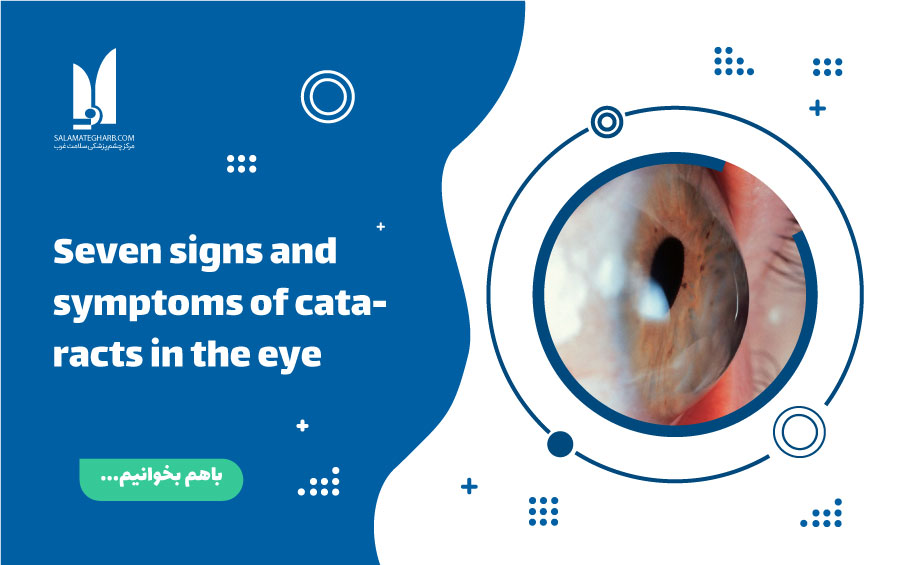7 Signs and symptoms of eye cataracts
Cataracts are insignificant at first and may have little impact on your eyesight. You use eye lenses every day, from reading books to running and watching birds. As you age, the accumulation of proteins within your eye lens causes eye lenses to become opaque, which makes eye vision difficult and leads to cataracts.
Some behaviors can increase the risk of eye lens cataracts and cause vision problems, including:
- Excessive exposure to the sun without eye protection
- Tobacco use
- High blood sugar
- Use of steroid drugs
- Exposure to radiation
- 1. Cloudy days
Cataracts are insignificant at first and may have little impact on your eyesight. Objects may look a little blurry, like watching an Impressionist painting. This effect of vision usually increases over time. The world looks cloudy, blurry or dark.
After reconstructive surgery for cataracts, you may be surprised to see the world again with all its colors.
There are three types of cataracts that affect different parts of the lens of the eye:
- Posterior shrewd cataracts
- Nuclear cataracts at the lens center of the eye
- Cortical cataracts on the peripheral part of the lens of the eye that appear as small veins
People with nuclear cataracts may experience temporary improvements in their eyesight. This feeling is sometimes called “secondary vision.”
Lens cataracts occur not only in the elderly, but also in young people.
- 2. More caution at night
As cataracts progress, objects are darkened by a shade of yellow or brown. It affects vision and night vision and makes night activities such as night driving difficult. In fact, a study from The University of Curtin, Australia, has found that cataract treatment reduces the risk of traffic accidents by 13 per cent.
If you suspect cataracts, be very careful at night and do not drive with poor vision and vision.Cataracts affect vision and night vision, making night activities such as night driving difficult.
- 3. Glare of light
Sensitivity to light is one of the most common symptoms of cataracts. According to the Mayo Clinic Institute, light glare can be painful, especially in people with posterior shrewd cataracts. This type of cataract begins behind the lens of the eye and blocks the path of light and often impairs a person’s vision while studying.
- 4. Is there an aura of light everywhere?
The matting of the lens of the eye can lead to the diffraction of the incoming light to your eyes. This situation can cause you to see an aura around light sources. Circles around any light source, sometimes appearing in different colors, can make driving very difficult. This is another reason why driving at night in case of cataracts, especially when there are street lights and car lights, can be risky.
Driving at night in case of cataracts, especially when there are street lights and car lights, can be risky.
- 5. New glasses again
If you regularly need stronger glasses or contact lenses, you may have cataracts. Simply buying a study glasses from a pharmacy won’t fix the problem.
If your eyesight changes quickly, see an ophthalmologist. You may have cataracts or other eye diseases that are treated as quickly as possible.
If you regularly need stronger glasses or contact lenses, you may have cataracts.
- 6. Living in a yellow environment
As cataracts progress, the protein clumps that darken your lens may turn yellow or brown. This condition makes the incoming light look yellow to your eyes and is like using a blue light blocker glasses that prevent blue and purple light from entering the eye. This situation changes the way you view colors and reduces your ability to tell the difference between colors.
People with nuclear cataracts may experience temporary improvements in their eyesight .
After reconstructive surgery for cataracts, you may be surprised to see the world again with all its colors.
- 7. Double trouble
Light diffraction caused by the opacity of the eye lens in cataracts can cause you to see two or more images of the object. Different factors can cause double vision. Some of these factors include:
- Brain tumor
- Corneal swelling
- Multiple Sclerosis
- Stroke
- Cataracts
Light diffraction caused by the opacity of the eye lens in cataracts can cause you to see two or more images of the object. Binoculars, which makes two images visible only if both eyes are open, can be a sign of serious health concerns, including:
- Concussion
- High blood pressure or uncontrolled diabetes
- Graves’ disease
- Myasthenia Gravis
Single-eyed double vision, which causes several images to appear only in one eye, is most likely caused by a problem in the cornea or lens of the eye, which is the common cause of double vision as cataracts become larger.
See an ophthalmologist!
Cataracts can cause many changes in vision. Lens cataracts occur not only in the elderly, but also in young people. Damage, certain medications, and genetic conditions can lead to cataracts even at an early age.
Cataracts are a common cause of double vision.
It should be noted that not all vision changes are the result of lens cataracts. Some of the above symptoms can be a sign of very serious and life-threatening diseases. Tell an ophthalmologist to check for vision changes and other symptomsyou are experiencing.


Leave A Comment